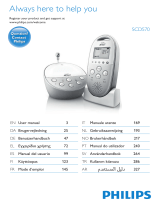
20
• If the ‘link’ light on the parent unit still does not
start ashing red, use the reset function to reset
the units to their default settings.
Whydoesthe‘link’lightontheparentunitash
red continuously and why is the message ‘NOT
LINKED’ or ‘LINKING’ shown on the display?
• The baby unit and the parent unit are out
of range of each other. Move the parent unit
closer to the baby unit.
• The baby unit may be switched off. Switch on
the baby unit.
Why does the battery status light on the baby
unitashred?
• The non-rechargeable batteries of the baby unit
are running low. Replace the non-rechargeable
batteries or connect the baby unit to the mains
(see chapter ‘Preparing for use’).
Why does the parent unit beep?
• If the parent unit beeps while the ‘link’ light
ashes red continuously and the message ‘NOT
LINKED’ or ‘LINKING’ is shown on the display,
the connection with the baby unit is lost. Move
the parent unit closer to the baby unit or switch
the baby unit on, if it was off.
• If the parent unit beeps and the battery symbol
on the display is empty, the rechargeable
batteries of the parent unit are running low.
Recharge the batteries.
• If you have set the room temperature range on
the parent unit and the temperature alert is on,
the parent unit beeps when the temperature
drops below the set minimum temperature
range or when the temperature rises above the
set maximum temperature range.
• The baby unit may be switched off. Switch on
the baby unit.
Why does the appliance produce a high-pitched
noise?
• The units may be too close to each other. Make
sure the parent unit and the baby unit are at
least 1 metre/3.5 feet away from each other.
• The volume of the parent unit may be too high.
Decrease the volume of the parent unit.
12 Guarantee and
support
If you need information or support, please visit the
Philips website at www.philips.com/support
or read the separate worldwide guarantee leaet.
13 Frequently asked
questions
This chapter lists the questions most frequently
asked about the appliance. If you cannot nd the
answer to your question, visit www.philips.com/
support for more frequently asked questions
or contact the Consumer Care Centre in your
country.
What is Eco Max mode? How does this mode
help the environment?
• The Eco Max mode has been developed to
enable you to reduce the energy consumption
of your baby monitor. When you monitor your
baby from a small distance, you can activate the
Eco Max mode. By switching on the Eco Max
mode, your baby monitor uses less energy and
is therefore more environment-friendly.
Why don’t the power-on light of the baby unit
and the ‘link’ light of the parent unit come on
when I press the on/off buttons of the units?
• Perhaps the rechargeable batteries of the
parent unit are empty and the parent unit is not
plugged in. Insert the small appliance plug into
the parent unit and put the adapter in a wall
socket. Then press the on/off button to establish
connection with the baby unit.
• Perhaps the non-rechargeable batteries of the
baby unit are empty and the baby unit is not
connected to the mains. Replace the non-
rechargeable batteries or connect the baby unit
to the mains. Then press the on/off button to
establish connection with the parent unit.






























